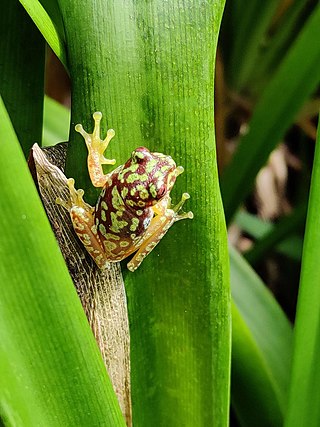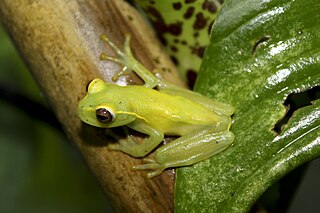The Honduran brook frog is a species of frog in the family Hylidae endemic to Honduras. Its natural habitats are subtropical or tropical moist lowland forests, subtropical or tropical moist montane forests, and rivers. Scientists have seen it between 90 and 1400 m above sea level in Honduras in rainforests.

The Copan brook frog is a species of frog in the family Hylidae found in northeastern Guatemala and northwestern Honduras, specifically in the Sierra del Merendón, Sierra de Omoa, Sierra de Caral, and Sierra Espíritu Santo ranges. The colouring of this species is very distinctive and the specific name soralia comes from the resemblance of its markings to the vegetative structures on some crustose lichens.

Agalychnis lemur, the lemur leaf frog or lemur frog, is a species of frog in the subfamily Phyllomedusinae. It is found in Costa Rica, Panama, and adjacent northwestern Colombia. It is classed as Critically Endangered and threatened by the fungal disease chytridiomycosis.
Hyloscirtus alytolylax, called the babbling stream frog, babbling torrenter, or tadapi tree frog in English, is a species of frog in the family Hylidae found in Colombia and Ecuador. Its natural habitats are subtropical or tropical moist lowland forests, subtropical or tropical moist montane forests, and rivers. It is threatened by habitat loss. Scientists have observed it in Colombia between 500 and 2159 meters above sea level and in Ecuador between 400 and 2000 meters above sea level.

The La Loma tree frog is a species of frog in the family Hylidae found in Costa Rica, Panama, and expected but not confirmed in Colombia. Its natural habitats are tropical moist lowland and montane forests, with breeding taking place in streams. It is threatened by habitat loss and chytridiomycosis.
Boana latistriata is a species of frog in the family Hylidae. It is endemic to Brazil and only known from its type locality, Itatiaia National Park, and from Marmelópolis, both in the state of Minas Gerais. The specific name latistriata refers to the wide stripes on the back of this frog.
Isthmohyla zeteki is a species of frogs in the family Hylidae native to the Cordillera Central and Cordillera de Talamanca of Costa Rica and western Panama. The specific name zeteki honors James Zetek, an American entomologist who worked in Panama. Common name Zetek's treefrog has been coined for the species.

The green-eyed treefrog is a species of Australasian treefrog in the subfamily Pelodryadinae that occurs in the Wet Tropics of Australia.

Phytotriades is a genus of tree frogs in the family Hylidae. As currently delimited, the genus is monotypic and contains Phytotriades auratus, commonly known as the golden tree frog, bromeliad-dwelling treefrog, El Tucuche golden tree frog, or Trinidad heart-tongued frog.
Atlantihyla panchoi, also known as the Guatemala stream frog, is a species of frog in the family Hylidae. It is endemic to eastern Guatemala and is only known from three localities in the Sierra de las Minas and Montañas del Mico ranges. The specific name panchoi honors Laurence Cooper "Don Pancho" Stuart, an American herpetologist.

The Ceiba stream frog is a species of frog in the family Hylidae endemic to Honduras. Its natural habitats are subtropical or tropical moist lowland forests, subtropical or tropical moist montane forests, and rivers. It is threatened by habitat loss.

Scinax alter, the Crubixa snouted treefrog, is a species of frog in the family Hylidae endemic to Brazil.

Scinax boulengeri is a species of frog in the family Hylidae. It is found in Colombia, Costa Rica, Nicaragua, Panama, and possibly Honduras. Its natural habitats are subtropical or tropical moist lowland forests, intermittent freshwater marshes, pastureland, plantations, rural gardens, and urban areas. It has been found as high as 600 meters above sea level.

Ecnomiohyla rabborum, commonly known as Rabbs' fringe-limbed treefrog, is a possibly extinct species of frog in the family Hylidae. They were relatively large frogs that inhabited the forest canopies of central Panama. Like other members of the genus Ecnomiohyla, they were capable of gliding by spreading their enormous and fully webbed hands and feet during descent. The males of the species were highly territorial and would guard water-filled tree holes used for breeding. They were also the ones responsible for guarding and caring for the young, including providing food. They were the only known species of frog where the tadpoles derived nutrition by feeding on the skin cells of their fathers.
Osteocephalus castaneicola is a species of frog in the family Hylidae. It is found in lowland Amazonia of northern Bolivia, adjacent southeastern Peru, and western Brazil. It breeds in water-filled fruit capsules of the Brazil nut, a characteristic also alluded to in its specific name castaneicola derived from the Latin castanea, the root of the vernacular name castaña for the Brazil nut, together with the Latin colō meaning "to inhabit".
The Lenca leopard frog is a species of true frog found in the Chortis Highlands of southwestern Honduras at altitudes of 1560 to 2080 m. This frog was long thought to be a hybrid between the two lowland species Lithobates brownorum and Lithobates forreri until 2018 when DNA tests proved the highland leopard frogs to be a distinct species. They are smaller in size but have larger heads than the two lowland species, with males growing between 46.6–64.3 mm (1.83–2.53 in) while females grow between 43.7–76.3 mm (1.72–3 in). The Lenca leopard frog is named after the Lenca people, who inhabit the same mountainous region as the frog.

Atlantihyla is a genus of frogs in the family Hylidae. It is endemic to Central America, specifically to Honduras and Guatemala. The generic name refers to its distribution on the Atlantic side of the isthmus. The members of the genus are known as stream frogs.
Osteocephalus vilarsi is a frog in the family Hylidae endemic to the state of Amazonas in Brazil and the state of Amazonas in Venezuela. Scientists think it might also live in Colombia. This frog lives in white-sand forests.
Phrynomedusa dryade, the monkey frog, is a species of frog in the family Hylidae, endemic to Brazil. Scientists have only seen it in five places, always in ponds or mountain streams.
Bromeliohyla melacaena is a frog in the family Hylidae endemic to Honduras. Scientists have observed it in pine forests between 1370 and 1990 meters above sea level.









